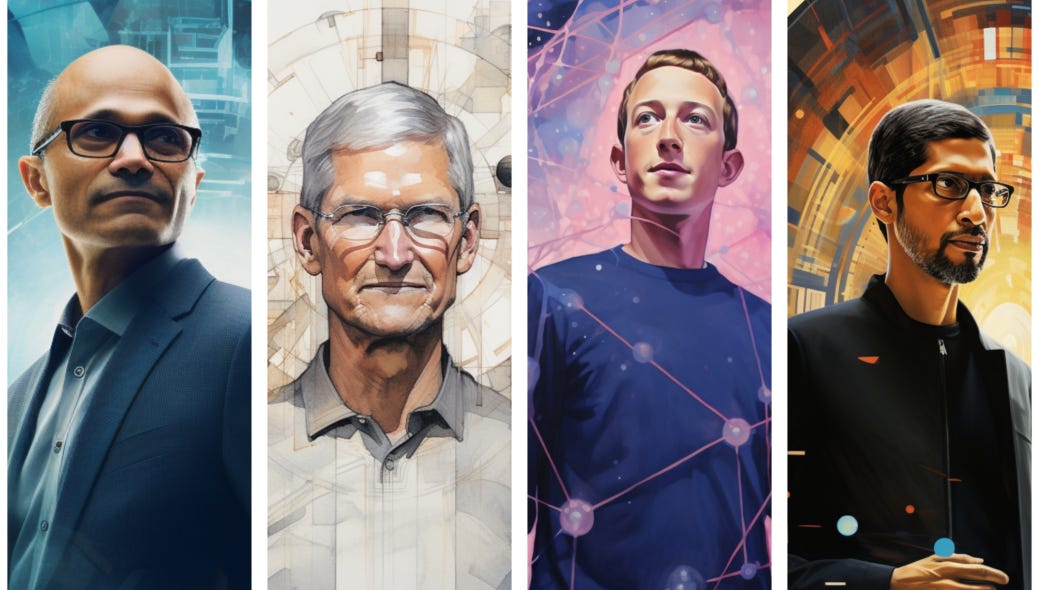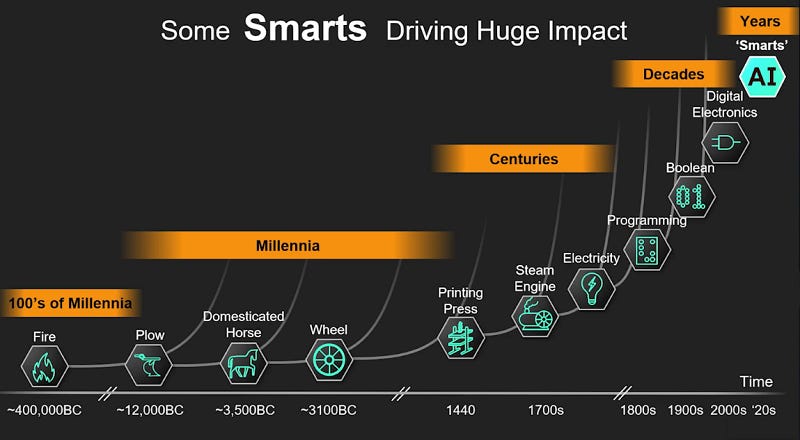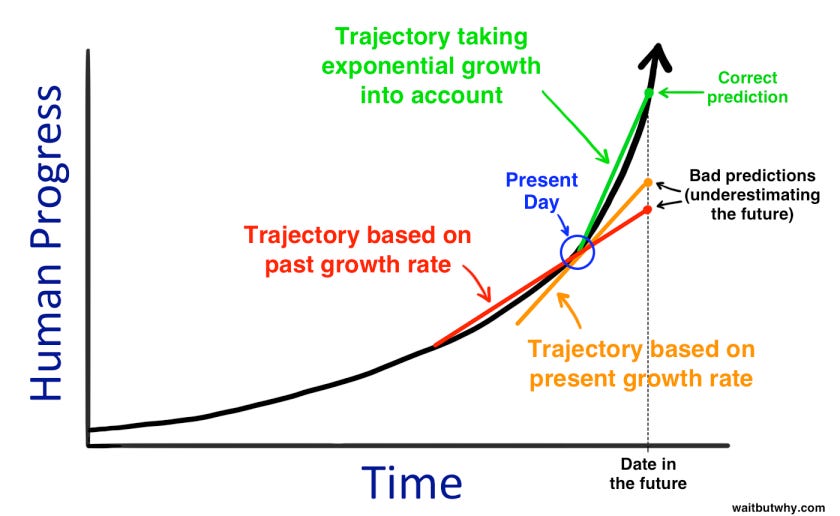MBA Hiring Is Plummeting— a Yale AI Course that has changed my views...
Traditional Career Paths are Being Disrupted —and the One Skill You Need to Stay Ahead
I remember the first time I used ChatGPT 4 a few years ago, and realized something fundamentally different was happening in the business world. It wasn’t a seismic boardroom shake-up or a viral tweet from a Fortune 500 CEO. Rather, it was the rapid iteration of language models like ChatGPT, Claude, and DeepSeek—tools that seemed more science fiction than business technology just a few years ago.
Since then, this trend has only accelerated. I’m currently taking two technically focused AI courses at Yale, and can’t help but observe how these models are not just an interesting curiosity; they’re fast becoming the operational engine of future enterprises. The real question is whether we, the next generation of managers, entrepreneurs, and finance professionals, are ready for it.
I believe now more than ever that reduced MBA job placement rates are due to structural factors (driven by AI) rather than mere cyclical economic reasons…
The Structure of Corporate America is Changing
In many ways, the challenges facing younger people today—stagnating wages, a ruthless housing market, ballooning student debt—are exacerbated by these rapid technological shifts. The very structure of corporate America is changing, and so are the social dynamics that govern who rises to the top. For the emerging professional class, the bar will no longer be set by only by a prestigious credential or decades of experience. The bar will be set by an uncanny ability to harness and direct these new AI-driven workflows.

In other words, there’s a new premium on raw intellectual horsepower—IQ, if you will—because the tasks we delegate to these models demand sharp, data-driven judgment. Gone are the days of purely “experience-based” management where hierarchy and politics ruled. Equally gone are the days where half of your work flow is doing administrative tasks like filling in a spreadsheet, performing routine data analysis, and spending days on a KPI PowerPoint. We’re entering an era of “data-informed leadership,” where success hinges on how quickly you can interpret, refine, and execute insights generated by AI, and increasingly tasks completed by them.
At the same time, MBA placement rates have been famously down this past year—much to the chagrin of business school students and administrators. The prevailing narrative is that this is just a cyclical downturn, another wave in the economic tide. But the more I learn about AI and its potential to reshape how companies are structured and how decisions get made, the more convinced I am that something structural is going on.
We’re not merely seeing a dip in the economy; we’re witnessing the beginning of a profound realignment in the skills that matter and the roles that companies value.
Adapt or Vanish
Historically, MBAs have stood on a pillar of case-based learning, networking, and leadership development. The notion was simple: learn to manage people, master strategic frameworks, and you’ll thrive in corporate environments that prized these soft skills. That was certainly true in the 1960’s to the 1990’s when companies were essentially largely about managing people. Then in the 1990’s with the advent of personal computers and software, it became about managing people who use technology. From then until the late 2010’s, the biggest leaps in technology were computers, spreadsheets, and enterprise software—tools to streamline tasks people still largely owned.
But the tidal wave of Large Language Models (LLMs) has ushered in a new category of skill. It’s no longer enough to just “lead” people. Increasingly, you must know how to lead machines—and not in a superficial way. We’re talking about building entire data lakes and workflows where AI agents, automate tasks, create strategic documents, execute on important operations, and assist inmaking decisions in microseconds that used to take managers days or weeks to prepare
It’s the ability to design, set up, and refine these AI-driven pipelines that will separate the winners from the losers. If you picture a future boardroom, gone are the endless PowerPoints where mid-level managers present curated slides to directors who then “weigh the pros and cons.” Instead, decisions will be heavily informed by real-time data streaming into sophisticated AI systems. Human business owners and managers will be responsible for asking the right questions, interpreting the results, and—most importantly—steering the outputs in the right direction.
From the coursework I’ve encountered at Yale, I see an explicit push toward working with integrated LLM workflows, LangChain and refinement processes. The subtext is loud and clear: if MBAs wish to remain relevant, they need to think more like engineers—constantly testing, iterating, optimizing while keeping the big picture business strategy in mind. Agility will trump longevity in almost every sphere of corporate life. Understanding the big picture and managing these workflows to achieve that vision. Completing manual tasks such as Excel data input, financial modeling, and filling in standardized internal documents will go by the wayside.
AI at Warp Speed
When ChatGPT first gained widespread attention, most of us marveled at its ability to write coherent prose, draft emails, or summarize documents. Fast forward just a few months, and we’re inundated with new players like Claude and DeepSeek, each showcasing novel capabilities and improvements. The rate of iteration is dizzying. What took AI researchers a decade to achieve is now being rolled out in months.
We’ve also seen the cost of running these models decrease substantially. Training and inference, once the domain of well-capitalized tech giants, is spreading to smaller startups and academic labs. Companies like DeepSeek are aggressively pushing the boundaries, and this competition drives prices down even further.
What does this mean for corporate America? It means that the adoption of AI is no longer optional or a “moonshot.” It’s table stakes. If your competitor invests in AI-driven workflow optimization and you don’t, they will quickly outstrip you on speed, cost-efficiency, and quality of insights. The result is a new arms race—except the “arms” in question are algorithms, cloud infrastructure, and talent capable of orchestrating them.
Brains vs. Bots: Human IQ in the Age of AI
We often debate the role of IQ in career success. Soft skills—like empathy, teamwork, and communication—have long been touted as the cornerstones of modern leadership. But the modern workplace is evolving. With AI handling more and more of the routine tasks, the human role is pivoting toward high-level judgment, critical thinking, and strategic oversight.
This doesn’t mean emotional intelligence (EQ) is suddenly worthless. Rather, it suggests a shift: the best executives of tomorrow will have to parse complex data sets, diagnose problems in AI pipelines, and spot patterns the machines might miss. They’ll need to do this without getting bogged down in office politics or endless consensus-building. In this new environment, raw cognitive ability—the capacity to deal with complexity swiftly and accurately—becomes extremely valuable.
To be clear, I’m not advocating for an elitist approach where only those with stratospheric IQs can succeed.
Instead, I’m underlining the reality that technology is leveling the playing field in certain domains (like rote analysis, structured communication, or even coding), and so individuals who can make high-level connections will be at a distinct advantage. Think about it: if AI can draft your business plan, forecast your financials, and handle your marketing funnel, then the limiting factor is no longer your ability to execute tasks. It’s your ability to define the right tasks in the first place and interpret the results in a way that creates value. That requires an immense sense of vision, judgment, and raw processing power.
When AI Takes the Wheel
The traditional corporate structure resembled a pyramid, with executives at the top making “visionary” decisions, managers in the middle translating those decisions into operational tasks, and frontline workers carrying them out. This model is now upended by AI systems capable of running entire workflows end-to-end. We still need humans to set the strategic direction and to maintain oversight, but the layers of middle management once dedicated to supervising tasks could soon become obsolete or radically repurposed.
I see it unfolding like this: rather than assigning tasks to human subordinates, managers of the future will set up LLM-driven workflows. They’ll define the inputs and desired outputs, specify checkpoints for quality control, and ensure compliance with regulations. Then they’ll let the AI run the process—24/7, with no breaks and at near-zero marginal cost. The manager’s job becomes one of system architect and quality inspector, stepping in only when the AI flags an anomaly, or when the strategic context changes and the workflows need re-optimization.
This is a deeply different skillset from what’s been taught in business schools for decades. Instead of focusing on leadership styles, motivational theories, and case-based heuristics, the future curriculum will hinge on building, running, and troubleshooting AI systems. That’s not to say leadership and soft skills won’t matter—they certainly will in forging partnerships, building company culture, and maintaining stakeholder relationships. But at an operational level, the prime directive is: Can you configure these AI pipelines effectively?
Traditional Corporate Jobs on Shaky Ground
Now, let’s talk about MBA placement rates. In times of economic uncertainty, companies cut back on hiring, especially for higher-cost positions like MBAs. But the drop we’re seeing in placement rates feels like more than a cyclical dip. The structural change is that many roles traditionally filled by junior MBAs—like financial modeling, market research, or strategy analysis—are increasingly automated or made vastly more efficient by AI.
Companies realize they might not need a full team of associates if a single manager can leverage LLMs for a fraction of the cost. This creates a new set of pressures on young professionals: how do you differentiate yourself in a market that’s shifting to machine-driven efficiency?
In short, it requires a commitment to deep domain expertise. This means not just having the basic MBA skills which are becoming a commodity, but truly understanding the dynamics of a specific sector or function, and being able to review AI-prepared documents, strategies, and workflows, refine them, and execute on them.
We all need to become an expert in setting up and managing these AI workflows. If you’re the person who can train the system, refine it, and interpret its results, you’re more valuable than ever. You’re not just another associate cranking through an Excel sheet; you’re the orchestrator of a complex digital process. This expertise can command a premium, and ironically, it might be the path toward bridging that wealth gap that young people find so daunting.
That said, we also face a looming question: does the proliferation of AI exacerbate or alleviate social and economic inequalities? On one hand, AI could democratize access to knowledge and tools that were once the domain of large corporations. Freelancers, small startups, and everyday entrepreneurs can now leverage powerful LLMs to scale their operations with minimal capital. This, in theory, could open the door to broader wealth creation.
On the other hand, if only a small subset of people learn how to effectively harness these tools, we may see an even greater concentration of wealth and power. Think about the last decade of Big Tech—those who mastered software development became the new elite. With AI, we risk creating an even more exclusive club of “machine orchestrators” who capture disproportionate benefits.
Blink and You’ll Miss It
From the perspective of recent events, the tech and consulting industry has experienced layoffs at major firms, even as they continue to pour billions into AI R&D and workflows. There’s a paradox here: we’re cutting traditional roles but pouring resources into the domain that makes those roles obsolete in the first place. Meanwhile, smaller AI startups are springing up, promising faster, more specialized models—pushing the ecosystem forward at breakneck speed. Each new update is encroaching on different job functions and we have not even entered the “specific vertical” AI application stage yet. Once domain specific AI applications are developed and integrated within industries, there will be even greater encroachment.
We’ve also seen a cultural shift in how people think about AI. It’s no longer a sci-fi novelty but a practical tool for day-to-day tasks. From drafting legal documents to coding websites, from customer service chatbots to strategic decision-making at consulting firms that goes straight to the C-suite of the Fortune 500, AI is everywhere. The velocity of improvements means that each month brings a new set of capabilities. If you blink, you might miss an entire wave of innovation that renders your current processes out-of-date.
Companies that successfully navigate this shift will do so by structuring entire workflows around AI. This means rethinking how teams are formed, how tasks are assigned, how data is captured, and how results are evaluated. Continuous refinement will be the name of the game, and those who can manage these cycles quickly stand to gain a massive competitive advantage.
This also suggests that barriers to entry in certain industries might rise—contrary to the democratizing narrative. Yes, the cost of AI is decreasing, but the complexity of setting up these systems effectively could increase. Firms that master AI integration sooner will have a head start, and that lead could compound over time as their models learn from more data.
The Future is Tomorrow
We are still, as they say, in the early innings. Even though it feels like AI is omnipresent, the real breakthroughs—more powerful models, cheaper compute, advanced multimodal capabilities—are still on the horizon. Consider what may happen as the smartest and most capable continue to pour into the industry to develop better and more capable models, while Big Tech and the Fortune 500 continue to invest trillions into the hardware and data server infrastructure over the next five years.
Imagine a world where AI can not only write text but proactively coordinate entire projects, from resource allocation to real-time market analytics. In such a world, the human role becomes even more strategic, focusing on top-level goals, ethical considerations, and creative problem-solving.
The cost to run these AI engines will continue to plummet. Competitive pressures among AI providers (and between countries like the USA and China) will force down prices for training and inference, making these tools more accessible to a wider range of organizations and individuals. For the youngest cohorts entering the workforce, this could be both a blessing and a curse. It’s a blessing because the leverage AI provides can be astounding—enabling a one-person startup to compete with established firms. It’s a curse because if you fail to adapt, the rug can be pulled out from under you almost overnight.

One might argue, as Naval Ravikant has in various contexts, that technology is a force multiplier. It amplifies your abilities but also magnifies any gaps you might have. If you’re a critical thinker, adept at learning new systems, and willing to continuously refine your approach, AI can amplify your efforts and potentially accelerate your path to wealth.
Conversely, if you rely solely on established hierarchies and outdated modes of work, you might find yourself in a tough spot. This is especially pertinent for younger generations grappling with student debt, rising housing costs, and fewer high-salary entry points. The hope is that AI, with its falling costs and rising capabilities, opens up new frontiers of value creation—from remote-first AI-driven startups to specialized consulting in AI orchestration, to novel products and services that wouldn’t have been profitable a decade ago.
It’s Your Move
We are living through a once-in-a-generation restructuring of how work is done and how value is created. From my vantage point at Yale, soaking up the lessons from courses on AI, I see a future where winning organizations pivot to “LLM-run workflows” and data-driven decision-making. The successful manager or entrepreneur won’t just be a charismatic leader or a brilliant technician—they’ll be a systems thinker, someone who can integrate AI into every facet of an operation while exercising strong judgment to guide these ever-evolving tools.
As for MBAs, they must evolve as well. The old template of case studies and leadership seminars must adapt to include robust training in data science, coding, AI ethics, and machine-human coordination. While it’s daunting, it’s also an opportunity. The wealth gap we witness today might be narrowed—or catastrophically widened—by how we handle this transition.
The pace is blistering, the stakes are high, and the competition is fierce. But for those willing to embrace this AI-driven world—learning, experimenting, and mastering new skills—the potential for value creation is unparalleled. After all, new frontiers are where fortunes are made.
It’s early, but the groundwork is already being laid for a new style of corporate America—one that demands sharper intelligence, faster iteration, and a willingness to let machines shoulder a massive share of the load. The question is, are you prepared to orchestrate them?
To staying ahead of the curve towards wealth, adventure, & freedom,
𝓝𝓪𝓽𝓮
P.S. If you’re an entrepreneur or business owner seeking independent, high-impact advice on managing your wealth, investments, and tax optimization, apply to work with me at Grey River. Don’t be left behind by relying on boilerplate financial advice. Reach out at shantz@grey-river.com to schedule a consultation and discover how a tailored, holistic approach can propel your financial future.
Thank you for reading. For more insights on capital markets, AI, and the shifting gears of wealth creation, subscribe to my SubStack at Scholar of Capital and follow Nate Shantz on LinkedIn.





